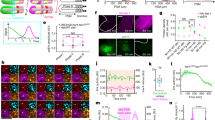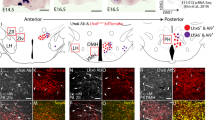Abstract
A primordial rhythm-generating neural network emerges during the segmental period of vertebrate hindbrain development, suggesting a common genetic basis to both the structure and network activity of the region. We show here that segmentation influenced a postsegmental developmental step by which a GABAergic rhythm generator was incorporated into the primordial network and increased rhythm frequency to near mature values. This process depended on specifications in r3 and r5 that controlled, on the basis of a two-segment repeat, later maturation of GABAergic inhibition.
This is a preview of subscription content, access via your institution
Access options
Subscribe to this journal
Receive 12 print issues and online access
$209.00 per year
only $17.42 per issue
Buy this article
- Purchase on Springer Link
- Instant access to full article PDF
Prices may be subject to local taxes which are calculated during checkout




Similar content being viewed by others
References
Edlund, T. & Jessel, T. M. Progression from extrinsic to intrinsic signaling in cell fate specification: A view from the nervous system. Cell 96, 211–224 (1999).
Lumsden, A. & Krumlauf, R. Patterning the vertebrate neuraxis. Science 274, 1109–1115 (1996).
Fortin, G., Kato, F., Lumsden, A. & Champagnat, J. Rhythm generation in the segmented hindbrain of the chick embryo. J. Physiol. (Lond.) 486, 735–744 ( 1995).
Champagnat, J. & Fortin, G. Primordial respiratory-like rhythm generation in the vertebrate embryo. Trends Neurosci. 20, 119–124 (1996).
Hamburger, V. & Hamilton, H. L. A series of normal stages in the development of the chick embryo. J. Morphol. 88 , 49–92 (1951).
Fortin, G., Foutz, A. S. & Champagnat, J. Respiratory rhythm generation in chick hindbrain: effect of MK-801 and vagotomy. Neuroreport 5, 1137 –1140 (1994).
Jacquin, T. D. et al. Reorganization of pontine rhythmogenic neuronal networks in Krox-20 knockout mice. Neuron 17, 747–758 (1996).
Fortin, G., Champagnat, J. & Lumsden, A. Onset and maturation of branchio-motor activities in the chick hindbrain. Neuroreport 5, 1149 –1152 (1994).
Harris, N. C. & Constanti, A. Mechanism of block by ZD 7288 of the hyperpolarization-activated inward rectifying current in guinea pig substantia nigra neurons in vitro. J. Neurophysiol. 74, 2366–2378 (1995).
Gasparini, S. & Di Francesco, D. Action of the hyperpolarization-activated current (I h) blocker ZD7288 in hippocampal CA1 neurons. Pflugers Arch. 435, 99– 106 (1997).
Lüthi, A., Bal, T. & McCormick, D. A. Periodicity of thalamic spindle waves is abolished by ZD7288, a blocker of I h. J. Neurophysiol. 79, 3284–3289 ( 1998).
Delcomyn, F. Neural basis of rhythmic behavior in animals. Science 210, 492–498 (1980).
Fénelon, V. S., Casanovas, B., Simmers, J. & Meyrand, P. Development of rhythmic pattern generators. Curr. Opin. Neurobiol. 8, 705–709 ( 1998).
Wilkinson, D. G., Bhatt, S., Chavrier, P., Bravo, R. & Charnay, P. Segment-specific expression of a zinc-finger gene in the developing nervous system of the mouse. Nature 337, 461–464 (1989).
McGinnis, W. & Krumlauf, R. Homeobox genes and axial patterning. Cell 68, 283–302 (1992).
Lumsden, A. & Keynes, R. Segmental patterns of neuronal development in the chick hindbrain. Nature 337, 424– 428 (1989).
Taneja, R. et al. The expression pattern of the mouse receptor tyrosine kinase gene MDK1 is conserved through evolution and requires Hoxa-2 for rhombomere-specific expression in mouse embryos. Dev. Biol. 177, 397–412 ( 1996).
Seitanidou, T., Schneider-Manoury, S., Desmarquet, C., Wilkinson, D. G. & Charnay, P. Krox-20 is a key regulator of rhombomere-specific gene expression in the developing hindbrain. Mech. Dev. 65, 31–42 (1997).
Xu, Q., Mellitzer, G., Robinson, V. & Wilkinson, D. In vivo cell sorting in complementary segmental domains mediated by Eph receptors and ephrins. Nature 399, 267– 271 (1999).
Flanagan, J. G. & Vanderhaeghen, P. The ephrins and Eph receptors in neural development. Annu. Rev. Neurosci. 21, 309–345 (1998).
Wan, Q. et al. Recruitment of functional GABAA receptors to postsynaptic domains by insulin. Nature 388, 686– 690 (1997).
Wang, H., Bedford, F. K., Brandon, N. J., Moss, S. J. & Olsen, R. W. GABA(A)-receptor-associated protein links GABA(A) receptors and cytoskeleton. Nature 397 , 69–72 (1999).
Torres, R. et al. PDZ proteins bind, cluster, and synaptically colocalize with Eph receptors and their ephrin ligands. Neuron 21, 1453–1463 (1998).
Xia, J., Zhang, X., Staudinger, J. & Huganir, R. L. Clustering of AMPA receptors by the synaptic PDZ domain-containing protein PICK1. Neuron 22, 179–187 (1999).
Brückner, K. et al. EphrinB ligands recruit GRIP family PDZ adaptor proteins into raft membrane microdomains. Neuron 22, 511–524 (1999).
Cherubini, E., Gaiarsa, J. L. & Ben-Ari, Y. GABA: an excitatory transmitter in early postnatal life. Trends Neurosci. 14, 515– 519 (1991).
LoTurco, J. J., Owens, D. F., Heath, M. J., Davis, M. B. & Kriegstein, A. R. GABA and glutamate depolarize cortical progenitor cells and inhibit DNA synthesis. Neuron 15, 1287–1298 (1995).
Wagner, S., Castel, M., Gainer, H. & Yarom, Y. GABA in the mammalian suprachiasmatic nucleus and its role in diurnal rhythmicity. Nature 387, 598–603 ( 1997).
Wilkinson, D. G. in In Situ Hybridisation, a Practical Approach (ed. Wilkinson, D. G.) 1–83 (IRL Press, Oxford, 1992).
Acknowledgements
This work was supported by CNRS, the Fondation pour la Recherche Médicale, a Human Frontier Science Program RG0101/1997-B grant to J.C. and an EEC grant to S. J. We thank V. Abadie for help with mouse-embryo recordings, V. Prince and D. Wilkinson for gifts of probes to Hoxb1 and Krox-20, respectively, and J. Gilthorpe and A. Coutinho for reading the manuscript.
Author information
Authors and Affiliations
Corresponding author
Rights and permissions
About this article
Cite this article
Fortin, G., Jungbluth, S., Lumsden, A. et al. Segmental specification of GABAergic inhibition during development of hindbrain neural networks. Nat Neurosci 2, 873–877 (1999). https://doi.org/10.1038/13172
Received:
Accepted:
Issue Date:
DOI: https://doi.org/10.1038/13172
This article is cited by
-
The whisking oscillator circuit
Nature (2022)
-
Perchance to dream? Primordial motor activity patterns in vertebrates from fish to mammals: their prenatal origin, postnatal persistence during sleep, and pathological reemergence during REM sleep behavior disorder
Neuroscience Bulletin (2015)
-
Linking respiratory rhythm generation to segmentation of the vertebrate hindbrain
Pflügers Archiv - European Journal of Physiology (2003)



